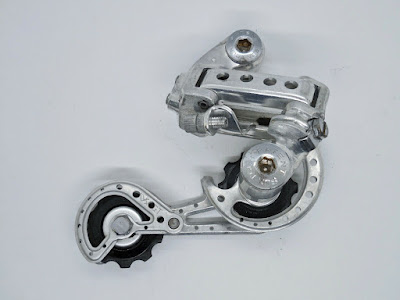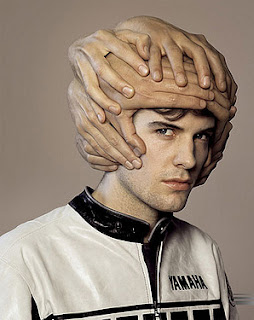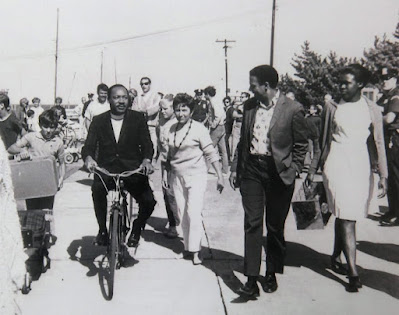Steel to aluminum to carbon.
Hand-built wheels to boutique wheelsets.
Hubs and freewheels to freehubs and cassettes.
Quill stems to threadless; threaded headsets to threadless.
The "baselines" for bikes and components have changed so much in the past couple of decades. While some of those changes are beneficial to some cyclists, too many simply added cost and complication for others.
Those changes have also brought innovators and investors with deeper pockets than the mom-and-pop operations that dominated cycling until the 1980s. One way you can see what I mean is to look at the sponsors of riders and teams: Jerseys in the 1960s and 1970s bore the names of local or regional enterprises like Molteni and the bikes and components were made by companies (or sometimes individuals) that were involved mainly, or solely, in the bike industry. Now bike and component makers tend to be parts of larger conglomerates, and sponsors include them as well as large companies (like Coca-Cola) that have little or nothing to do with the design or manufacture of bikes or parts.
Like all changes, the ones I've mentioned have brought casualties, if you will. Some once-revered bike, component and accessory makers no longer fabricate their wares in Europe, Japan or the United States--or might build one or two of their most expensive models in their home country while outsourcing the manufacture of their mass-market goods to low-wage countries. Still others are no longer in the bike business--or in business at all.
And then there are smaller (what might be called "niche" in other industries) enterprises that ended when the main or sole proprietor--or even employee--retired, died or simply wouldn't or couldn't change with the rest of the industry. I think in particular of small-scale frame builders like Ron Cooper and Brian Bayliss who had small but devoted followings.
Another change came with the ones I've mentioned. When I first became a dedicated cyclist, nearly half a century ago, high-mileage cyclists almost always wore wool--year round. Those black shorts you see on cyclists from the 70s were made from it; so were there jerseys. That, of course, is why bike kit of that time wasn't as flashy as today's: Since colors and patterns have to be knit into wool, it's much more difficult (if not impossible) to include some of the intricate (or busy) graphics and loud colors you see on the "billboard" jerseys and matching shorts (or bibs) of today.
During the North American Bike Boom of the 1970s, some companies got into the business of making bike clothing. Most are gone now--offhand, I can think of Protogs and Weyless. And there were the European, mostly Italian, makers. One reason the American apparel makers--aside from one I'll mention--didn't last more than a few years was that many cyclists had an attitude expressed by one shop employee I encountered: "Buy right, buy Italian." Also, Weyless (which made some nice components) claimed their wool clothes wouldn't shrink. Well, shrink they did, and it's said that the warranty claims torpedoed a business that was already sinking as the tide of the Bike Boom receded.
And, honestly, most of the Italian clothes fit (at least folks like me in those days) better. But one American company, almost entirely unknown save to dedicated cyclists, made wool shorts, jerseys, arm and leg warmers and other apparel that were better-constructed with higher-quality wool.
That company was based, seemingly incongruously, in Southern California. Well, that location seems incongruous to anyone who doesn't understand wool: Because it wicks moisture, it helps to keep you cooler. And it keeps more of its insulating qualities than other materials when wet. That is why it's been worn by people who live in areas that experience both extreme heat and cold, as well as other kinds of harsh weather.
John Kucharik Jr. has been extolling those virtues for the past 50 years. He's about to turn 69 and, he says, he promised his wife they would "travel and do some stuff." So, although his company's sales grew during the pandemic, he is about to close the business his father, who died at age 93 in 2008, founded 88 years ago.
That anyone can keep a business going for that long, with the family's surname, while making products that changed little, if at all, is an achievement. And he's done it with the same workforce--seven people--for the past thirty years. That, I think, may be a reason why he's closing up rather than selling out: They're "my family," he says. "I tell people: They don't work for me; I work for them."
It will be sad to lose one of the last companies to make bike apparel from wool, or any other natural material (e.g., cotton and leather in the gloves). But the cycling world will lose something else: a place that repairs bike bibs, shorts and other items. "I don't make money on repairs," Kucharik explains, "I just do it because I do it. My dad did it; I did it." Their repairs include replacing or re-sewing pads and fixing zippers. "[T]hese guys pay $200, $250, $300 for a bib short. They ride it once and they can't ride it again. A bike shop doesn't want it back." He said his shop was averaging about 40 such items--none made by his company--a week.
The closing of Kucharik Bicycle Clothing company also is another change in the bike industry. Call me a cynic, but the more expensive bike clothes (and other items) become, the less durable they are. And the bike industry has become more like the fashion industry and others in that it seems more oriented to affluent cyclists who won't ride a jersey, a pair of shorts or bibs--or a bike--for more than a season.

































